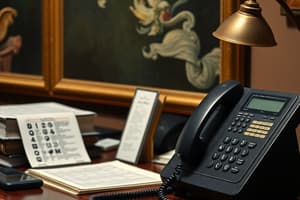Podcast
Questions and Answers
What is the primary purpose of office procedures?
What is the primary purpose of office procedures?
- To ensure efficiency and productivity (correct)
- To increase the number of meetings
- To create a relaxed work environment
- To encourage informal communication (correct)
Which procedure involves guidelines for email and phone communication?
Which procedure involves guidelines for email and phone communication?
- Meeting Management
- Communication Protocols (correct)
- Time Management
- Document Management
What is a technique used for prioritizing tasks in time management?
What is a technique used for prioritizing tasks in time management?
- Emergency response plans
- Eisenhower Matrix (correct)
- Version control
- Budget tracking
Which of the following best describes the importance of compliance in office procedures?
Which of the following best describes the importance of compliance in office procedures?
What action can help improve office procedures over time?
What action can help improve office procedures over time?
Flashcards are hidden until you start studying
Study Notes
Office Procedures
Definition
- Set of standardized processes and practices that guide daily operations in an office environment.
Importance
- Ensures efficiency and productivity.
- Enhances communication and teamwork.
- Establishes consistency in tasks and responsibilities.
Common Office Procedures
-
Communication Protocols
- Guidelines for email, phone, and in-person communication.
- Use of professional language and tone.
-
Document Management
- Procedures for filing, storing, and retrieving documents.
- Version control to manage document updates.
-
Meeting Management
- Scheduling procedures (using calendars, sending invites).
- Agenda preparation and minute-taking.
-
Time Management
- Techniques for prioritizing tasks (e.g., Eisenhower Matrix).
- Use of tools (calendars, task lists) for time tracking.
-
Financial Procedures
- Expense reporting and approval workflows.
- Budget tracking and financial forecasting.
-
Human Resource Procedures
- Recruitment, onboarding, and training processes.
- Employee performance evaluation protocols.
-
Health and Safety Procedures
- Emergency response plans (fire drills, evacuation routes).
- Workplace ergonomics and safety training.
-
Technology Use
- Guidelines for software, hardware, and data security.
- IT support procedures for troubleshooting issues.
Best Practices
- Regularly review and update procedures.
- Train staff on procedures to ensure compliance.
- Encourage feedback to improve existing processes.
Documentation
- Create a manual or handbook that outlines all office procedures.
- Include flowcharts or diagrams for complex processes.
Compliance
- Ensure that office procedures adhere to relevant laws and regulations.
- Regular audits to assess adherence to procedures.
Continuous Improvement
- Implement systems for monitoring and assessing the effectiveness of procedures.
- Foster a culture of innovation to adapt and enhance office operations.
Definition
- Standardized processes guide daily operations in an office environment.
Importance
- Enhances efficiency and productivity across tasks.
- Fosters better communication and teamwork among employees.
- Promotes consistency in roles and responsibilities.
Common Office Procedures
-
Communication Protocols
- Guidelines establish standards for email, phone, and in-person interactions.
- Emphasizes the importance of a professional tone and language.
-
Document Management
- Outlines procedures for filing, storing, and retrieving documents effectively.
- Incorporates version control to track and manage document updates.
-
Meeting Management
- Details scheduling methods, including calendar usage and sending invitations.
- Involves preparing agendas and taking minutes for effective record-keeping.
-
Time Management
- Introduces techniques for task prioritization, such as the Eisenhower Matrix.
- Recommends tools like calendars and task lists for efficient time tracking.
-
Financial Procedures
- Defines workflows for expense reporting and approvals.
- Focuses on budget tracking and financial forecasting for fiscal responsibility.
-
Human Resource Procedures
- Covers recruitment, onboarding, and training protocol for new hires.
- Establishes methods for employee performance evaluation.
-
Health and Safety Procedures
- Develops emergency response plans, including fire drills and evacuation routes.
- Promotes workplace ergonomics and safety training initiatives.
-
Technology Use
- Sets guidelines for the use of software, hardware, and data security measures.
- Describes IT support procedures for troubleshooting and resolving issues.
Best Practices
- Regular reviews and updates of procedures ensure relevance and accuracy.
- Staff training on procedures helps maintain compliance and understanding.
- Feedback mechanisms encourage continuous improvement of office processes.
Documentation
- Creation of a manual or handbook is essential for outlining all office procedures.
- Flowcharts and diagrams are helpful for illustrating complex processes visually.
Compliance
- Office procedures must align with applicable laws and regulations.
- Regular audits are necessary to evaluate adherence to established procedures.
Continuous Improvement
- Systems for monitoring the effectiveness of procedures promote ongoing refinement.
- A culture of innovation is encouraged to adapt and enhance office operations.
Studying That Suits You
Use AI to generate personalized quizzes and flashcards to suit your learning preferences.




